 |
 Toledo also has a great Gothic Cathedral. The north tower stands 295 feet (90m) high and was built from 1380-1440. The south tower was left unfinished and is capped with a Baroque dome which makes this "Gothic" Cathedral, extremely unusual. And one last highlight of Toledo was the Church of Santo Tome which houses El Greco's famous painting 'The Burial of the Count of Orgaz'. No Pictures were allowed so I took this off the Internet. We had a fabulous guide who was able to really dissect this painting for us and help us understand it. Toledo and its cobblestone streets was a truly charming little village with much to offer.
Toledo also has a great Gothic Cathedral. The north tower stands 295 feet (90m) high and was built from 1380-1440. The south tower was left unfinished and is capped with a Baroque dome which makes this "Gothic" Cathedral, extremely unusual. And one last highlight of Toledo was the Church of Santo Tome which houses El Greco's famous painting 'The Burial of the Count of Orgaz'. No Pictures were allowed so I took this off the Internet. We had a fabulous guide who was able to really dissect this painting for us and help us understand it. Toledo and its cobblestone streets was a truly charming little village with much to offer.
We continued through the dry plains of Don Quixote's La Mancha, before crossing the Sierra Nevada to reach Granada, capital of the Moorish Kingdom of Spain until the Moors' defeat in 1492. You can see the influence of the Muslims to this day. What I will remember about Granada is the complex of buildings called the Alhambra Palace.
 |
| Alhambra |
 |
| Gardens in Alhambra |
 |
| Patio of Charles V |
Our next destination: Cordoba.
The Mezquita de Cordoba is the most important building in the city. The Emir started in the year 785 with the construction of a mosque which was extended several times and with an area of 23,000 square meters would be the third largest in the world today. About 860 marble columns in parallel rows, each carrying two overlapping arcs. King Ferdinand reconquered Cordoba from the Moors in 1236. The mosque eventually turned into a Cathedral with a place where Jews and Muslims may also worship.


 |
| Orange Tree Courtyard outside the Mosque. |
*** *** *** ***
Seville....final resting place of Christopher Columbus and the Flamenco show! Evidently, other places claim to house the remains of Columbus (who was buried and reburied several times), but we were informed that the Sevilla Cathedral is the only location where DNA testing on the remains has confirmed family links.
 |
| Christopher Columbus tomb. |


We were then treated to a fantastic Flamenco dinner show at the El Palacio Andaluz. Flamenco came to Spain via India and incorporates singing, instrumental accompaniment, and dancing using fans, shawls, capes and walking sticks. This Flamenco dancer with the girls has won multiple awards and is apparently, a local celebrity.
The next set of pictures is taken of the Spanish Pavillion from the Ibero-american World's Fair Exposition.


The next set of pictures is taken of the Spanish Pavillion from the Ibero-american World's Fair Exposition.


And below you will find the family enjoying some free-time in the fashionable Santa Cruz Quarter with its flower decked wrought iron balconies, one of which is said to have housed famed lover Don Juan.


 I can't forget the Bullring. The Plaza De Toros is one of the most visited monuments of the city. Below the Bullring is a museum. I learned quite a bit about the Bulls that fight...these Bulls are no younger than 5 years old and have been wild, wandering the hills/mountains of Seville.
I can't forget the Bullring. The Plaza De Toros is one of the most visited monuments of the city. Below the Bullring is a museum. I learned quite a bit about the Bulls that fight...these Bulls are no younger than 5 years old and have been wild, wandering the hills/mountains of Seville.
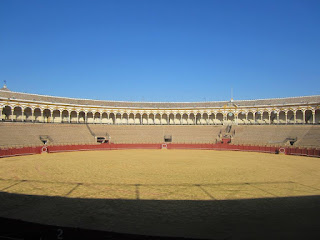

Lastly, we went on a tour of the Royal Palace. The Royal Family in Spain do stay at this Palace in Seville, although their main home is in Madrid. We were not allowed in the private living quarters but did get a good glimpse of the gardens and main floor of the home.












Okay, now on to Sintra and Cascais. Sintra was a sweet, very touristy town that had expensive pottery and linens. I was so tempted because I had heard Portugal is so much cheaper than Switzerland, but I found the prices to be high, even for hand made items. I only bought a few little hand painted bowls for olive pits...they are so cute!
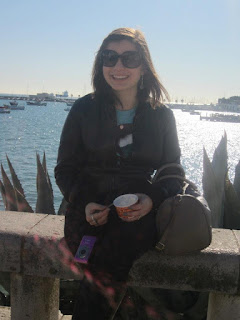
Next destination: Fatima, Christmas Day.



Then our last stop before returning to Madrid was Salamanca (Spain), famous for it's beautiful golden stone buildings.








 |
| Santa Cruz Quarter |


I learned that the people in Spain put up mangers (elaborate ones) instead of Christmas trees. I did see many many trees however, many more mangers were the center decor. There were beautiful managers in many of the Christmas markets for purchase, but this one had to be the cutest manger of all. Can you see everyone dressed in Flamenco dresses??
*** *** *** ***
 I can't forget the Bullring. The Plaza De Toros is one of the most visited monuments of the city. Below the Bullring is a museum. I learned quite a bit about the Bulls that fight...these Bulls are no younger than 5 years old and have been wild, wandering the hills/mountains of Seville.
I can't forget the Bullring. The Plaza De Toros is one of the most visited monuments of the city. Below the Bullring is a museum. I learned quite a bit about the Bulls that fight...these Bulls are no younger than 5 years old and have been wild, wandering the hills/mountains of Seville.


Lastly, we went on a tour of the Royal Palace. The Royal Family in Spain do stay at this Palace in Seville, although their main home is in Madrid. We were not allowed in the private living quarters but did get a good glimpse of the gardens and main floor of the home.




*** *** *** ***
One more tidbit before I go on...94% of the green olives imported to the United States come from Spain. I can't begin to guess how many Olive trees we saw. Miles and miles and miles!
*** *** *** ***
From Seville, we travelled to Portugal. Our first stop was in Lisbon or Lisboa if you are a native. The water was beautiful and the surrounding towns quaint. The first stop we made was Belem Quarter where the sailing ships set forth to discover unknown lands.








The weather was a nice change from the weather we were and are having in Switzerland.
Okay, now on to Sintra and Cascais. Sintra was a sweet, very touristy town that had expensive pottery and linens. I was so tempted because I had heard Portugal is so much cheaper than Switzerland, but I found the prices to be high, even for hand made items. I only bought a few little hand painted bowls for olive pits...they are so cute!
 |
| Ira sampling the Port Wine. |
 |
| A view of Sintra |

That night we enjoyed watching a Fado performance which is very different from the Flamenco show. You could see more of the British influence in the dancing, much like the dancing they perform in Ireland. I'm disappointed we don't have any good pictures but this one captures Ira and me, as we were asked to come on stage and dance! There was also a Fado singer who seemed to be fond of Brenna too.
Next destination: Fatima, Christmas Day.
Fatima is the most celebrated place of pilgrimage in Portugal. We visited the Basilica commemorating the appearance of the Virgin Mary to three children in 1917.



Then our last stop before returning to Madrid was Salamanca (Spain), famous for it's beautiful golden stone buildings.

Back in Madrid, now at the Presidential palace. Unfortunately, no pictures inside were allowed.















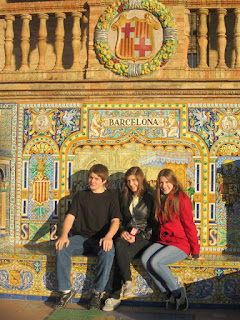













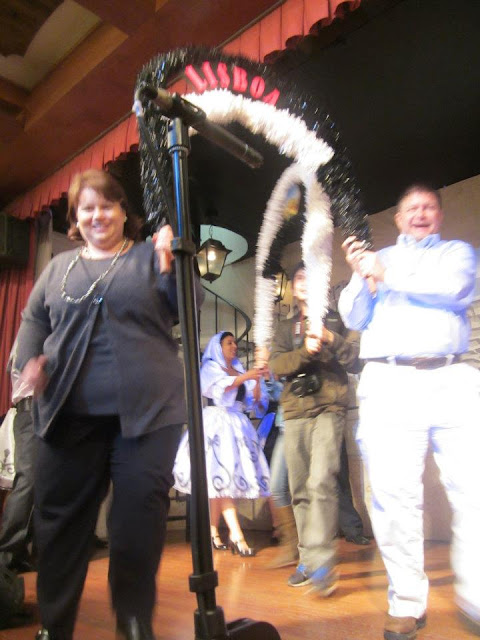











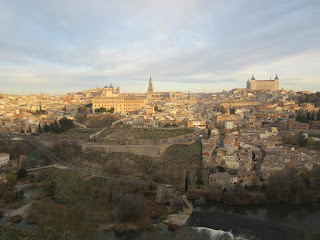

No comments:
Post a Comment